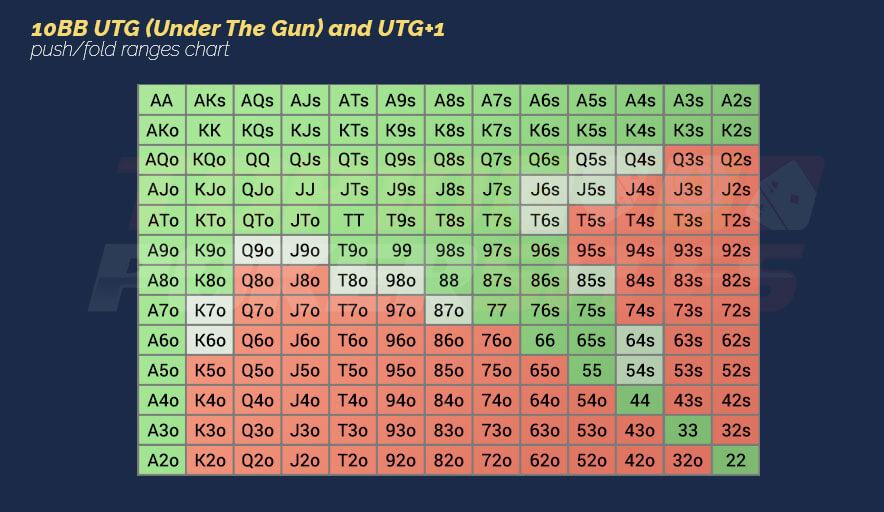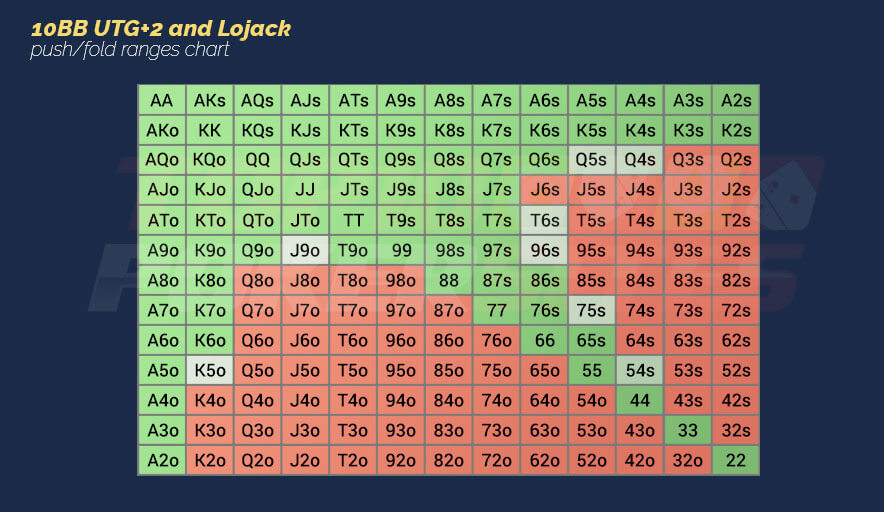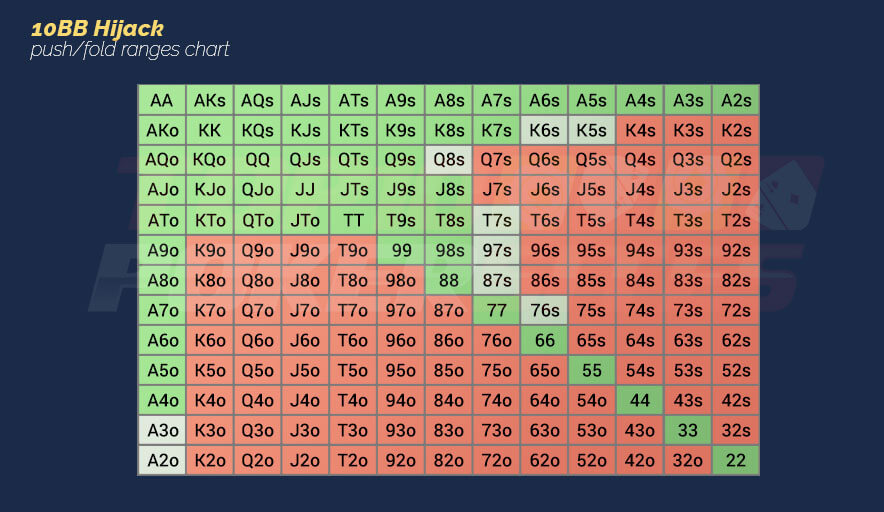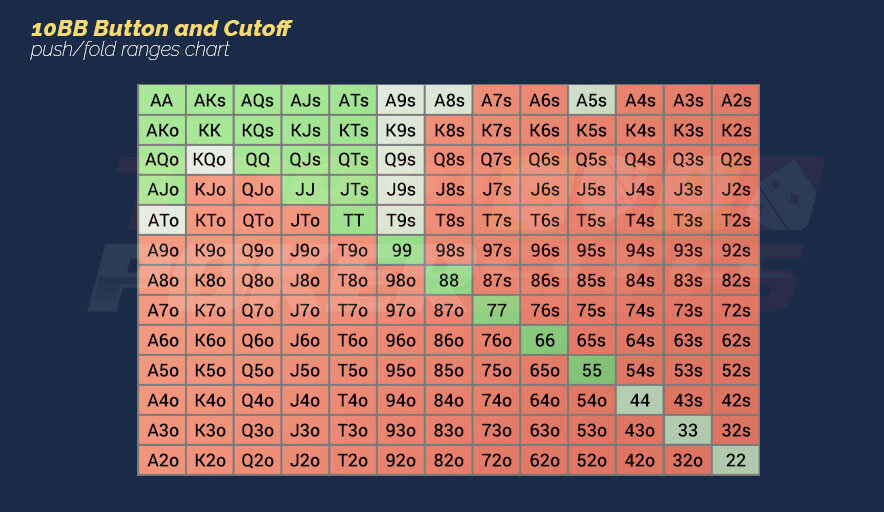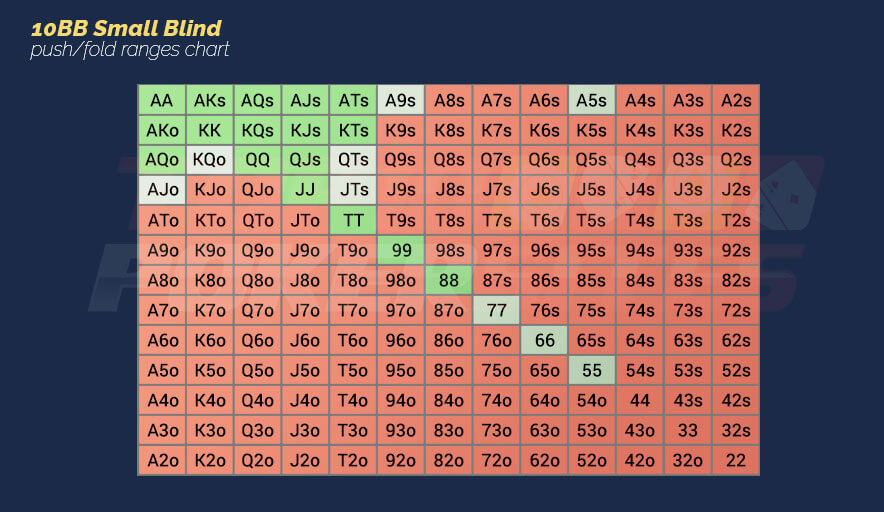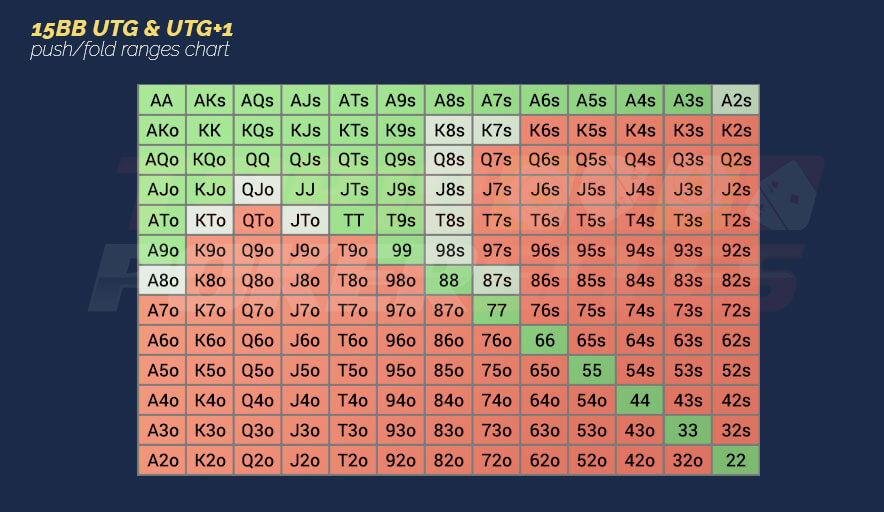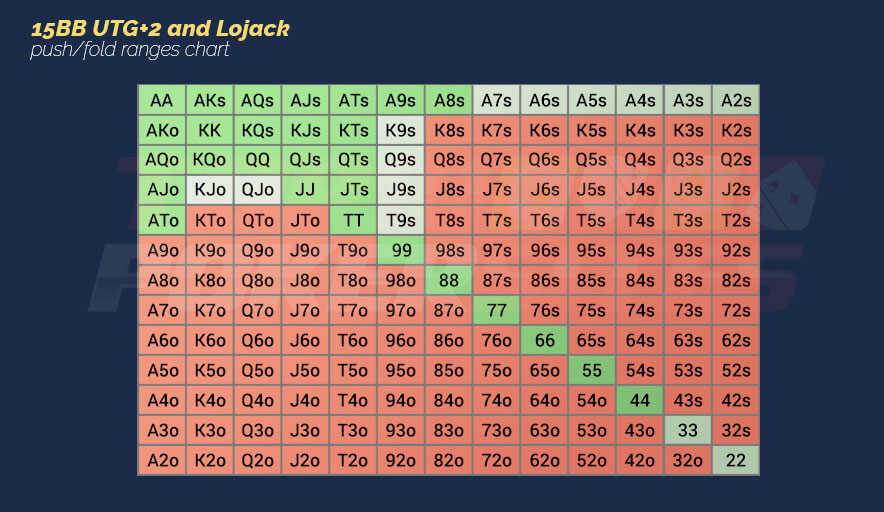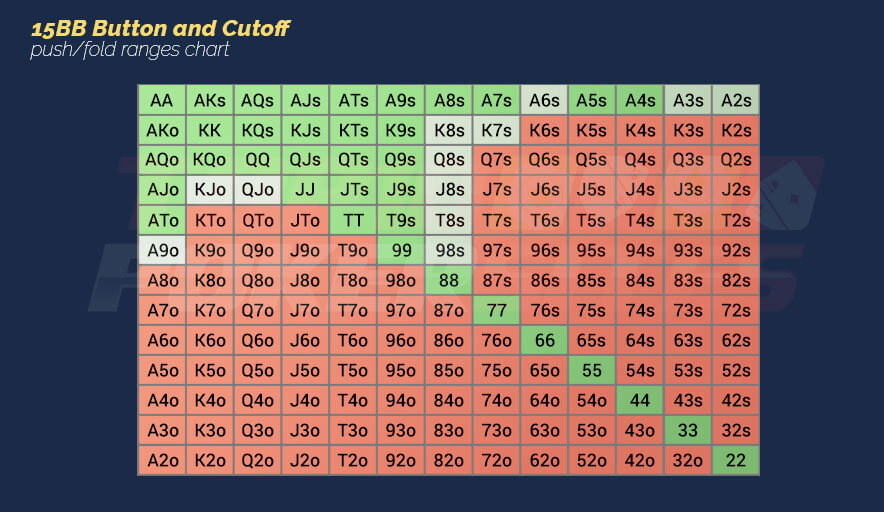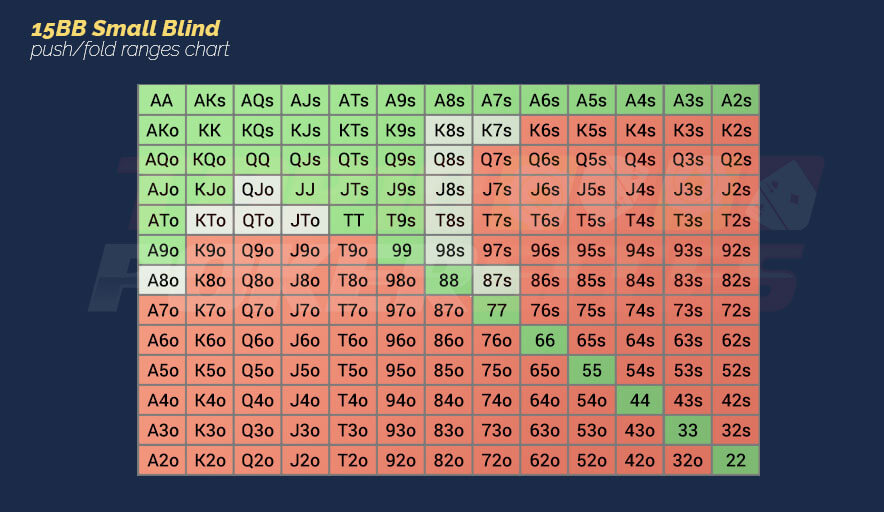Push/Fold Charts in Tournament Play
Push/fold charts are one of the most popular tools players use to improve their tournament play. We teach you what they are and how you can use them.
 Playing poker can be satisfying, fun, and challenging, but its true brilliance shines through on competitive playgrounds like tournaments. Most players know this, so there’s an abundance of strategies, charts, and tactics for improving your tournament play out there.
Playing poker can be satisfying, fun, and challenging, but its true brilliance shines through on competitive playgrounds like tournaments. Most players know this, so there’s an abundance of strategies, charts, and tactics for improving your tournament play out there.
This article discusses one that is both popular and effective — the push/fold strategy and charts. Read on to learn what push/fold strategy is and how you can use its charts to your benefit.
Use this link to jump straight to the charts.
What Is the Push/Fold Strategy?
The strategy became popular as poker tournaments’ structures changed with time. Over the years, tournaments became shorter and more fast-paced, and their blinds level dropped. It became evident that dominating in preflop was the only way to win in this type of structure. The push/fold strategy emerged as one of the more reliable and successful ways to accomplish this goal.
At first glance, the push/fold strategy may appear too risky. Aggressive actions like going all-in or completely throwing away your hand would leave you with no wiggle room. They seem even more inconvenient in the context of the bubble when the strategy recommends using them. No player wants to be out of the game at the cutoff point and go home with no money.
However, it’s not all so black and white. Limping or raising in or around the bubble can allow your opponents to pressure you by raising your bet or calling with a weaker hand and then hitting in the flop. The push/fold strategy’s aggressive play reverses this power dynamic. It can force your opponents to fold out hands with good equity and increase your stack before the flop begins.
What Are Push/Fold Charts?
Push/fold charts are tables with mathematically solved hand ranges that should help you play optimal preflop poker when you’re short-stacked in a tournament. Their data is based on calculations worked out in complex poker programs like ICMIZER and PokerStove.These programs design hand ranges by measuring each hand’s expected value in chips (chip EV) when pushed. They assess chip EVs in the form of Big Blinds. For example, if the hand you’re thinking about pushing is above +0.2cEV, going all-in would result in a win most of the time. In other words, winning +0.20cEV every hand would mean you’re winning 20BB per 100 hands in the long run, which is an incredible win rate.
Push/fold chart calculators take numerous factors into account to create ranges for each spot. Some include:
- Seating
- Stack depth
- Tournament structure
- Number of players remaining in the game, and many other conditions
They also account for the percentage of time you’ll get called and then lose or win — your equity when called — before making recommendations.
To that end, you can find many types of push/fold charts that address different situations players might face. They’ve even become advanced enough to make calculations for the game theory optimal (GTO) strategy and what is known as the Nash equilibrium concept.
Push/Fold Ranges and Charts
Now that you’re familiar with the push/fold basics, it’s time to look at some of the charts we’ve discussed above.The following pictures will show 10 and 15BB push/fold charts for UTG (Under the Gun), UTG+1, UTG+2, Lojack, Hijack, Cuttoff, Button, and Small Blind positions at a 9-handed table. Positions with the same ranges are grouped in the same chart.
10BB Charts
The hands above +0.2cEV are considered slam dunk all-in hands and colored bright green. Slightly less advantageous are hands colored light green. They bring small profits and are worth risking your stack for in certain situations only. The rest of the hands are colored red, which means you’ll get the best results if you fold in these situations.10BB UTG and UTG+1
10BB UTG+2 and Lojack
10BB Hijack
10BB Button and Cutoff
10BB Small Blind
An analysis of these charts shows players have greater push all-in opportunities the further their position is along the table. Under-the-gun players have to have a reasonably strong range to push and land a win. The main reason for this finding is the number of players you’d push into with a 10BB stack. Naturally, your odds will be much better if you’re pushing into two instead of six players.
15BB Charts
A quick glance at the 15BB push/fold charts will reveal significant differences in EV when compared to previous 10BB charts. Overall, they advise pushing with slightly deeper stacks — around 20BB and less. You can take more +EV lines if you RFI (Raise First In) with larger stack sizes.Another piece of advice you may find useful has to do with off-suited aces. On the surface, these hands in a 15BB game may seem like a fantastic opportunity to push, no matter your stack depth. However, that’s not the case. The charts below show that the pushes on weak aces in UTG or middle positions are losing bets. Hands like J♠ T♠, for instance, are a much better all-in choice. Equity calculators will confirm the same.
15BB UTG & UTG+1
15BB UTG+2 and Lojack
15BB Hijack
15BB Button and Cutoff
15BB Small Blind
Note: These charts aren’t the only and ultimate guide when it comes to push/fold poker strategy. You may have to rely on different tactics depending on the conditions in the tournament and the game you’re playing.
How to Use the Charts to Improve Your Positions?
If you’re not new to gambling, you likely know or have used strategy charts like the push/fold tables we’ve attached above. The best way to optimize your play is to memorize them so you have all the relevant information at your disposal at all times. However, it’s also important to know you shouldn’t rely on them blindly.As mentioned earlier, many factors influence the outcome of your play in a tournament. The charts account for many, but not all of them. They don’t address two important elements: tournament life value (TLV) and your opponents’ tendencies and play style. TVL refers to a number of tournament aspects that differ between events, including breaking order, table difficulty, and hourly rate. You may have to make some unconventional changes to your play in connection to them to make the most of the game.
For the sake of better understanding, let’s look at an example. A push/fold chart may recommend pushing with 22+, A2o+, K2s+, K7o+, Q5s+, Q9o+, J7s+, J9o+, T6s+, T9o+, 96s+, 86s+, 75s+, 65s, and 54s and 12BB on the Button. However, you might profit more if you fold to a jam with a marginal holding or mid-raise if you’re facing a straightforward player who doesn’t push without a monster draw.
You might also have more winning opportunities if you’re playing against an opponent who tends to call too tight or fold marginal hands like Q2s or J9o. You should profit from a broader range of hands than the charts suggest in this situation.
Some additional tips for adjusting your play include:
- Push with a narrower range when close to a new pay jump to have a chance at bigger payouts.
- Push with a narrower range in a soft field to take a more optimal spot later on.
- Push with a narrower range when you have a lot of large stacks ready to call your all-in behind you.
These types of strategy modifications might require more work for beginners. They’re also less exploitative when you have under 10BB. You’ll have to give yourself enough time to overcome the learning curve and grow able to assess when to deviate from GTO. Playing more tournaments and practicing as much as possible should do the trick.
Best Poker Rooms To Play Online Tournaments
My list of the best poker sites which I consider to be the best rooms to play in 2024:- 100% Legal & Licensed
- Verified Bonus
- Mobile Friendly
- Advertiser Disclosure
Kindly be aware that some links on Top 10 Poker Sites are affiliate links, for which we may earn a commission. Find out more on our terms & conditions
- Must be 18+ to participate.
Displayed 3 of 8 rooms
Conclusion
Playing in tournaments is one of the best ways to experience poker today. You can refine and make the most of your play by relying on push/fold strategy charts. These tables will help to improve your preflop game, establish a strong position for the rest of the rounds, and win a good share of the pot.Start studying, memorizing, and practicing, and you’ll enter every game armed with enough knowledge to win.
FAQs
What are push/fold strategy charts?
Push/fold strategy charts are tables with mathematically calculated hand ranges that should help players play optimal short-stacked pre-flop poker in tournaments. Special poker programs like ICMIZER create them.
When should you shove in poker?
According to the push/fold charts, you’ll have better shoving opportunities the further you sit from the UTG position at the table. However, that’s only one of the factors you can use to determine whether you should push. The charts also take your stack size, number of players, game type, and other aspects into account.
Is push/fold an exploitative poker strategy?
It’s not. Push/fold strategy doesn’t account for the other players you’re facing in the tournaments. As a result, you might have to adjust the actions the charts recommend in relation to your opponent’s playing style to win.

